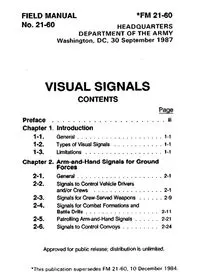
FM 21-60 Visual Signals 1987 PDF
Preview FM 21-60 Visual Signals 1987
CHAPTER 1 INTRODUCTION 1-1. General Visual signals are any means of communication that require sight and can be used to transmit prearranged messages rapidly over short dis- tances. This includes the devices and means used for the recognition and identification of friendly forces. 1-2. Types of Visual Signals The most common types of visual signals are arm-and-hand, flag, pyrotechnic, and ground-to-air signals. However, soldiers are not limited to the types of signals discussed and may use what is avail- able. Chemical light sticks, flashlights, and other items can be used provided their use is standardized within a unit and understood by soldiers and units working in the area. The only limit is the sol- dier’s initiative and imagination. 1-3. Limitations Visual signals have certain limitations a. The range and reliability of visual communications are significant- ly reduced during periods of poor visibility and when terrain restricts observation. b. They may be misunderstood. c. They are vulnerable to enemy interception and may be used for deception purposes. 1—1 CHAPTER 2 Arm-and-Hand Signals for Ground Forces 2-1. General Signals illustrated with a single arrowhead indicate that the signal is not continuously repeated; however, it may be repeated at intervals until acknowledged or the desired action is executed. Signals il- lustrated with double arrowheads are repeated continuously until ac- knowledged or the desired action is taken. Signals are illustrated as normally seen by the viewer. Some signals are illustrated in oblique, right angle, or overhead views for clarity. 2-2. Signals to Control Vehicle Drivers and/or Crews These are the arm-and-hand and light signals used to guide and direct vehicles. Flashlights are used at night to direct vehicles. Blue filters should be used whenever possible in order to preserve the driver’s night vision. Chemical lights can also be used and have less effect on the driver’s night vision (Figures 2-1 through 2-22). 2—1 2—2 2—3 2—4 2—5 2—6 2—7 2—8 2—9 2-3. Signals for Crew-Served Weapons Members of crew-served weapons must communicate. Often, this is in environments where visual signals are the best means of trans- mitting information (Figures 2-23 through 2-28). 2—10 2—11
